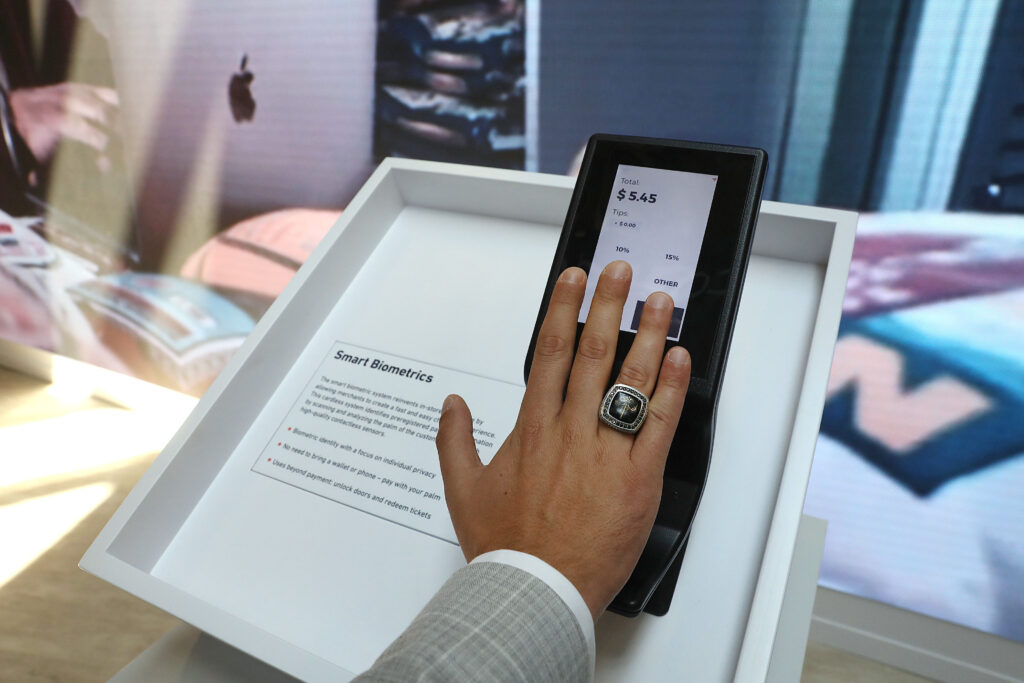
An employee demonstrates a concept biometric payment system on the Wirecard AG exhibition stand at the Noah Technology Conference in Berlin, Germany, on Thursday, June 13, 2019. The annual tech conference runs June 13 -14 and brings together future-shaping executives and investors. Photographer: Krisztian Bocsi/Bloomberg
The adoption of biometric payment systems is on the rise, with major players like Amazon and PopID launching in-store solutions across the United States. While consumers are familiar with tap-to-pay methods, using biometric options such as palm scans or facial recognition for payments remains a relatively new experience. Nevertheless, industry experts believe these technologies could reshape the payment landscape in the coming years. According to Christopher Miller, lead analyst at Javelin Strategy & Research, early adopters in the U.S. and pilot programs in countries like Brazil, Singapore, Japan, and South Korea may pave the way for broader acceptance.
A growing interest in biometric payments is evident among consumers. The Javelin 2024 North American Payment Insights Emerging Payments survey reveals that 68% of respondents have used biometrics for various purposes. Additionally, 47% expressed a likelihood to use biometric authentication at retail locations. Notably, banks are viewed as trusted custodians of biometric data by 41% of consumers, surpassing tech companies such as Apple and Google.
The PopID Model: A Practical Approach to Biometric Payments
PopID, a subsidiary of the investment firm Cali Group, has initiated biometric checkout at over 380 quick-service restaurant locations in the U.S. Recently, the company expanded its collaboration with J.P. Morgan Payments to roll out face recognition technology in select merchant locations. For instance, Whataburger reported improved checkout efficiency and increased customer loyalty through the use of biometric scans at self-order kiosks and counters. Customers register their biometric information via the Whataburger mobile app, ensuring consent and reducing privacy concerns that have historically plagued biometric data collection.
Amazon’s Innovative Approach
Amazon’s solution, known as Amazon One, utilizes palm-vein recognition technology. This method identifies individuals by assessing the unique vein patterns beneath the skin of their palms. Users simply hold their palm over the Amazon One device, which combines surface features like lines and ridges with subcutaneous vein patterns to authenticate the transaction. This technology is already operational at more than 500 Whole Foods Market locations and select Amazon stores, stadiums, airports, and fitness centers across the U.S.
Internationally, biometric payment initiatives are also progressing. In 2022, Mastercard launched a Biometric Checkout Program in Brazil in partnership with Payface, starting with five supermarkets in São Paulo. Customers can register their facial data through the Payface app, allowing them to complete transactions simply by smiling at the checkout. Recently, Mastercard announced its collaboration with NEC Corp. to extend this program to the Asia Pacific region.
In November 2023, Tencent partnered with Visa to introduce palm recognition technology for digital payments, starting in Singapore. Meanwhile, NEC plans to unveil a face recognition payment system at Expo 2025 in Japan, which runs until mid-October. Convenience stores in Seoul have also implemented facial recognition payment options.
Challenges and Future Outlook
Despite the potential for growth, several challenges hinder widespread adoption of biometric payment systems in the U.S. Miller notes that while current payment methods, such as tap-to-pay transactions, are efficient and have low fraud rates, consumers may initially be hesitant to switch to biometric payments without clear advantages.
Nevertheless, the future of payments may become more appealing if biometric systems can offer added benefits, such as access to sports arenas or other venues, alongside transaction capabilities. Miller emphasizes that advancements in technology may lead to continuous recognition systems, further enhancing the user experience by minimizing the need for re-authorization.
As biometric payment systems continue to evolve, their potential to revolutionize the checkout experience remains significant. With increasing consumer acceptance and technological advancements, it is likely that these systems will become a staple in retail environments around the world.






